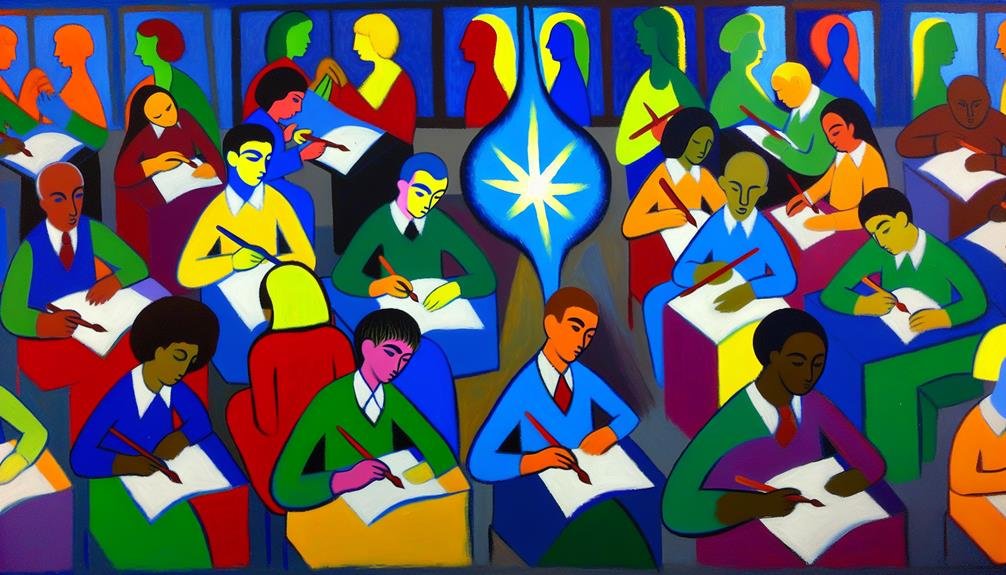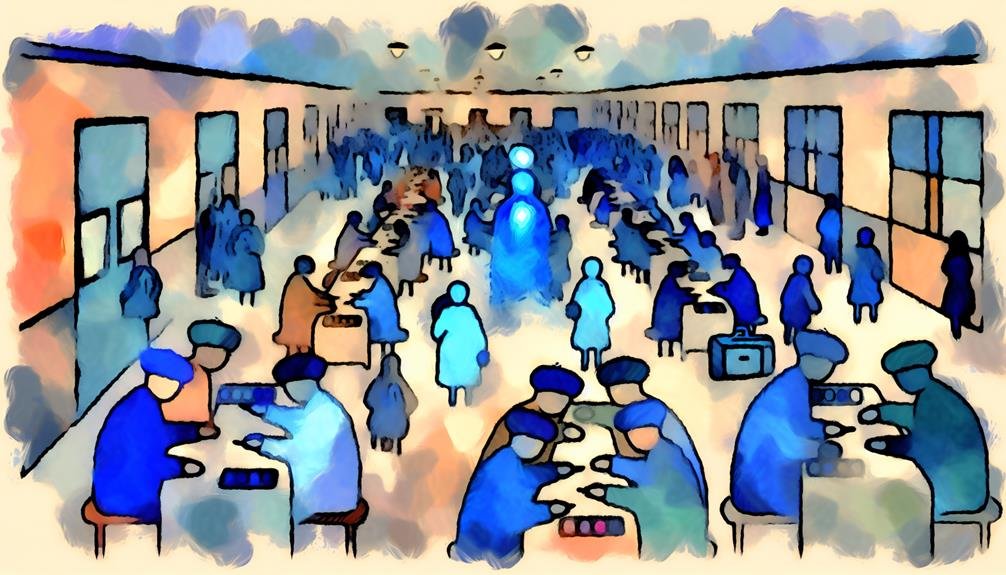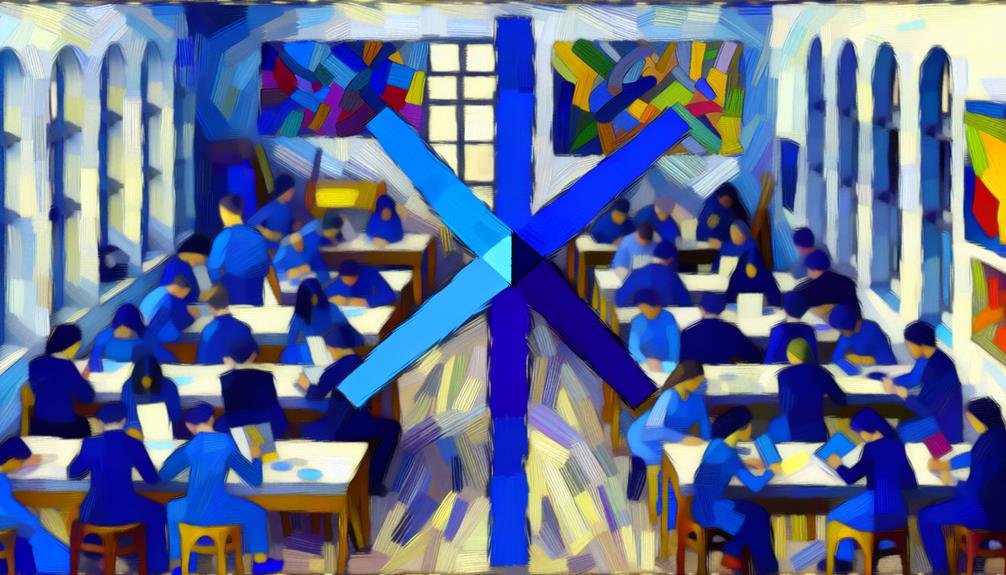Art education in schools is like a vibrant canvas of pros and cons. It boosts critical thinking, memory, and creativity, nurturing a rainbow of skills. From fostering empathy to empowering self-expression, it’s a vivid journey of personal growth. Yet, budget constraints can dull the colors, limiting resources and staff. The challenge is finding the right balance with core subjects while still painting a masterpiece of cultural appreciation. Art education can be the brush that colors your future success, enhancing problem-solving, communication, and confidence. It’s like mixing paints; the more you blend, the richer the outcome.
Takeaways
- Pros: Enhances critical thinking, creativity, and emotional intelligence.
- Cons: Budget constraints lead to reduced resources and limited access.
- Pros: Nurtures self-expression, individuality, and personal growth.
- Cons: Balancing art education with core subjects can be challenging.
- Pros: Develops transferable cognitive abilities and boosts future career opportunities.
Enhances Cognitive Development
Overall, art education in schools has been shown to greatly enhance cognitive development in students. By engaging in artistic activities such as drawing, painting, and sculpting, students are not only expressing their creativity but also honing their critical thinking skills. When faced with artistic challenges, students must analyze, problem-solve, and think outside the box to create their masterpieces. This process stimulates various regions of the brain, improving memory, attention span, and overall cognitive function.
Moreover, art education encourages students to observe, interpret, and communicate their thoughts and emotions effectively. These skills are essential for success in various academic subjects and real-world situations. Through art, students learn to pay attention to details, make connections between different concepts, and think abstractly. These cognitive abilities are transferable to other areas of learning, fostering a well-rounded and adaptable mind.
Ultimately, art education not only enriches students’ lives creatively but also empowers them with the cognitive tools needed to thrive in an ever-changing world.
Fosters Creativity and Innovation
Encouraging students to engage in artistic pursuits nurtures their ability to think creatively and innovate in various aspects of their lives. Art education provides a platform for students to explore their imagination, experiment with different materials, and express their unique perspectives. By delving into the world of art, students learn to think outside the box, problem-solve creatively, and adapt to new challenges with innovative solutions.
Creativity is like a muscle that grows stronger with practice, and art classes offer the perfect training ground for flexing those imaginative muscles. Whether through painting, sculpture, music, or dance, students are encouraged to push boundaries, take risks, and embrace new ideas. These skills transcend the art studio and can be applied to various subjects and real-life situations.
Innovation often stems from a spark of creativity, and art education ignites that spark within students. By fostering a culture of experimentation and originality, schools that prioritize art education cultivate a generation of forward-thinkers and innovators ready to tackle the challenges of tomorrow with fresh ideas and a creative mindset.
Improves Emotional Intelligence

Art education in schools isn’t just about painting pretty pictures or crafting sculptures; it’s about honing our emotional intelligence. By engaging in artistic activities, students learn to understand and empathize with others, enhancing their empathy skills.
Additionally, art allows for self-expression and encourages students to explore their emotions, ultimately cultivating social awareness in a colorful and creative way.
Enhances Empathy Skills
Enhancing empathy skills through art education in schools has been shown to greatly improve students’ emotional intelligence. By engaging in artistic activities like painting, drawing, or acting, students can step into the shoes of others, understand different perspectives, and develop a deeper sense of compassion and empathy towards their peers.
Through art, students have the opportunity to express emotions, thoughts, and experiences in a safe and creative way, which can help them connect with their own feelings and recognize similar emotions in others.
For example, when creating a piece of art based on a certain theme, students can explore how that theme makes them feel and then consider how others might react to it as well.
Moreover, art projects often involve collaboration and teamwork, encouraging students to communicate effectively, listen to different ideas, and work together towards a common goal. These experiences not only foster empathy but also help students build essential social and emotional skills that are valuable both inside and outside the classroom.
Fosters Self-Expression Abilities
Students engaging in art education in schools have the opportunity to enhance their emotional intelligence through the fostering of self-expression abilities. Art allows students to tap into their inner creativity, giving them a platform to express their thoughts, feelings, and experiences in a unique and personal way.
Here are five ways art education fosters self-expression abilities:
- Encourages personal reflection: Art prompts students to reflect on their emotions and experiences, helping them gain a deeper understanding of themselves.
- Boosts confidence: Through art, students learn to trust their instincts and make bold choices, ultimately boosting their self-confidence.
- Provides a safe outlet: Art serves as a safe and healthy outlet for students to vent their emotions and release stress in a constructive manner.
- Promotes self-awareness: Engaging in art activities encourages students to explore their thoughts and feelings, leading to greater self-awareness.
- Enhances communication skills: Art allows students to communicate complex emotions and ideas visually, improving their ability to express themselves effectively.
Cultivates Social Awareness
In addition, developing social awareness through art education in schools plays a significant role in enhancing students’ emotional intelligence by fostering empathy and understanding of others’ perspectives. Art allows students to explore different cultures, histories, and societal issues, opening their minds to diverse viewpoints and experiences.
By creating art that reflects social issues or by interpreting the works of artists who address such topics, students develop a deeper understanding of the world around them and the challenges that others may face.
Through collaborative art projects, students learn to communicate, compromise, and appreciate the contributions of others, fostering a sense of community and empathy. Additionally, discussing artworks and sharing interpretations help students practice active listening and respect for differing opinions.
These skills are invaluable in building strong relationships and resolving conflicts both in and out of the classroom.
Encourages Self-Expression and Individuality
Let’s imagine a world where every brushstroke, every color choice, and every creative decision is a celebration of who we are as individuals.
Art education in schools does just that – it nurtures our creativity, allowing us to express ourselves in ways that are as unique as our fingerprints.
Through art, we not only grow as artists but also as individuals, embracing our quirks and differences with pride and confidence.
Fosters Creativity and Uniqueness
Through the exploration of various artistic mediums, art education in schools nurtures the inherent creativity of students, fostering a sense of uniqueness by encouraging self-expression and individuality. Art classes provide a safe space for students to let their imagination run wild, to paint outside the lines, and to sculpt their ideas into tangible forms. This creative freedom allows each student to express themselves in a way that is authentic and true to their own experiences and emotions.
- Art education encourages students to think outside the box and explore unconventional ideas.
- It teaches them to embrace their mistakes and see them as opportunities for growth.
- Art classes help students develop their own artistic style and voice.
- They learn to appreciate the beauty in imperfection and the uniqueness of every individual’s perspective.
- Through art, students can communicate their thoughts and feelings in ways that words sometimes cannot capture.
In essence, art education empowers students to embrace their creativity, celebrate their individuality, and express themselves boldly and uniquely.
Promotes Personal Growth
Art education in schools serves as a catalyst for personal growth by nurturing students’ capacity for self-expression and individuality. Through art classes, students have the opportunity to explore their inner thoughts, feelings, and experiences in a creative and non-judgmental environment. This avenue for self-expression allows them to communicate their unique perspectives and emotions in ways that words sometimes cannot capture.
Encouraging individuality, art education empowers students to embrace their differences and celebrate what makes them special. It teaches them that it’s okay to think outside the box, to be bold, and to express themselves authentically. By fostering a sense of self-worth and confidence, art education helps students develop a strong sense of identity and self-awareness.
Moreover, the process of creating art can be incredibly therapeutic, providing students with a healthy outlet for managing stress, anxiety, and other emotional challenges. It allows them to channel their feelings into something beautiful and meaningful, promoting mental well-being and personal growth.
Art education truly nurtures the soul, encouraging students to embrace their true selves and shine brightly in the world.
Budget Constraints and Resource Allocation

How do budget constraints impact the allocation of resources for art education in schools? When it comes to funding for art programs, schools often find themselves facing tough decisions on where to allocate limited resources. Let’s explore how these budget constraints can influence the availability and quality of art education for students.
- Reduction in Art Supplies: Limited budgets may lead to a decrease in the variety and quantity of art supplies available to students.
- Cutbacks on Specialized Staff: Schools might have to make tough choices, potentially reducing the number of specialized art teachers or support staff.
- Limited Access to Technology: Lack of funds could restrict students’ access to technological tools and software for digital art creation.
- Decreased Opportunities for Field Trips: Budget constraints may result in fewer opportunities for students to visit museums, galleries, or art workshops.
- Impact on Extracurricular Activities: Financial limitations could affect the availability of art clubs, workshops, or after-school programs for students to further explore their creativity.
Balancing Art Education With Core Subjects
When considering the integration of art education in schools, finding a balance between the arts and core academic subjects is an important endeavor that requires thoughtful planning and allocation of resources. Both art and core subjects like math and language arts play essential roles in a student’s development. Striking a balance ensures that students receive a well-rounded education that nurtures their creativity while also fostering essential skills for their academic growth.
Let’s take a look at how we can balance art education with core subjects effectively:
| Benefits of Art Education | Considerations for Core Subjects |
|---|---|
| Enhances creativity and innovation | Guarantee students meet academic standards |
| Encourages self-expression | Time management for covering all subjects |
| Supports critical thinking skills | Integration of interdisciplinary topics |
| Promotes cultural appreciation | Assessment of student progress |
Potential Impact on Future Career Opportunities

Considering the growing demand for individuals with diverse skill sets in today’s competitive job market, the incorporation of art education in schools can greatly impact students’ future career opportunities. Art education nurtures creativity and critical thinking, skills highly valued in fields ranging from technology to marketing.
Here are five ways art education can shape a student’s career path:
- Enhanced Problem-Solving Skills: Art encourages students to think outside the box and find innovative solutions to complex problems.
- Improved Communication Abilities: Through visual expression, students learn to communicate ideas effectively, an essential skill in any profession.
- Boosted Confidence: Art empowers students to trust their instincts and take risks, crucial qualities for success in the workplace.
- Cultivated Collaboration: Working on art projects fosters teamwork and cooperation, skills sought after by employers in all industries.
- Diversified Skill Set: Art education equips students with a versatile skill set that can open doors to various career paths, from design to education.
Frequently Asked Questions
Can Art Education Positively Impact Students With Learning Disabilities?
Art education can positively impact students with learning disabilities by providing alternative ways to express themselves, fostering creativity, improving cognitive skills, boosting self-esteem, and enhancing social interactions. It can cater to diverse learning styles and promote holistic development.
How Can Art Education Support Students With Mental Health Challenges?
Art education can support students with mental health challenges by providing a creative outlet for expression, reducing stress, building self-esteem, fostering emotional growth, and promoting mindfulness. Art therapy techniques can also be integrated to enhance mental well-being.
Does Art Education Help Students Develop Critical Thinking Skills?
Art education provides students with opportunities to explore creativity, problem-solving, and self-expression, ultimately fostering critical thinking skills. Through analyzing and interpreting art, students develop the ability to think critically and express their ideas effectively.
Are There Benefits to Integrating Art Education With STEM Subjects?
Integrating art education with STEM subjects has shown numerous benefits, fostering creativity, innovation, and interdisciplinary skills. It enhances problem-solving abilities, encourages out-of-the-box thinking, and helps students develop a holistic approach to learning that is essential in today’s complex world.
How Can Art Education Address Cultural Diversity and Inclusion in Schools?
Art education can promote cultural diversity and inclusion in schools by fostering understanding, empathy, and appreciation for different perspectives and backgrounds. It provides a platform for students to express their unique identities and explore diverse artistic traditions.
Conclusion
To sum up, it is essential for schools to offer art education as it provides numerous benefits such as cognitive development, creativity, and emotional intelligence.
However, schools must also address challenges like budget constraints and finding a balance between art and core subjects. Despite these obstacles, the significance of art education in nurturing self-expression and individuality cannot be underestimated.
It is crucial for schools to find a balance that allows students to explore their creativity while also preparing them for future career opportunities.

